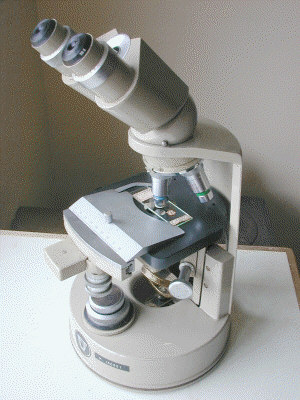 |
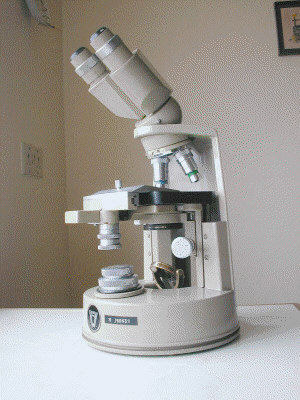 |
The Vickers Patholette Microscope |
 |
 |
As can be seen from the photo's above, the stand is unusual, though its general overall form was a deliberate design feature to provide a quality portable 'scope and hence the name 'Patholette'. Seemingly to suggest that it was capable of being used in the 'field for pathological work. It originally had a plastic 'dome' cover, but these tended to be broken and are rarely seen today.
It is not the most elegant of stands it must be said, but it has much to commend it, and if I were to only have one 'scope, this model would be very near the top of the list for a number of reasons which I will elaborate on below.
General design
The principle difference between this stand and most others can be seen instantly, as it lacks a traditional limb. In fact the 'limb' and 'foot' are included in one casting, such that the whole stand is rigid and relatively light, though it is by no means 'lightweight'.
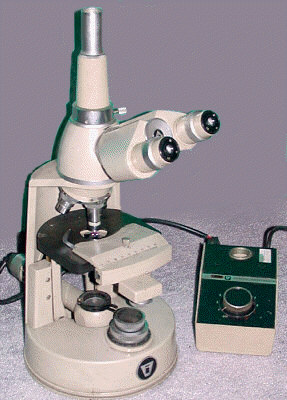 |
|
lamphouse and power supply |
The base is circular and houses the focusing mechanism, and the light mirror/electric lamphouse source is placed in the central depression in this circular base.
Interesting elements of design
Stage
The key feature of design that I appreciate is that the stage/substage assembly is housed in a well engineered roller/ballrace unit, which moves very smoothly in the main casting via nicely made 'roller slides'. Thus the stage is effectively rigid, yet with minimal overhang. The roller/ballrace contacts are almost as wide as the stage itself, providing high lateral stability yet very delicately controlled by the focussing unit inside the base.
The actual stage surface has ample proportions, and has a very durable black finish which in my example was virtually unmarked.
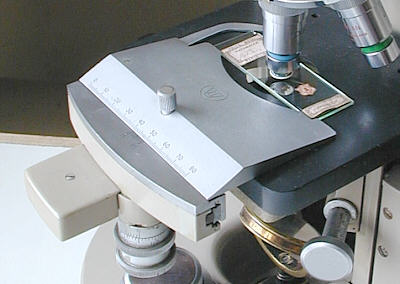 |
| Simple stage design with uncluttered finish |
Now we are getting to the heart of this microscope design. The focussing unit, which is a very old concept, is in my opinion superior in many categories to the traditional methods of coarse and fine focussing found on all classes of the instrument.
The principle used is based on the old screw lever found in many very old 19th Century microscopes. And having used it I can vouch for its sensitivity and practicality :-
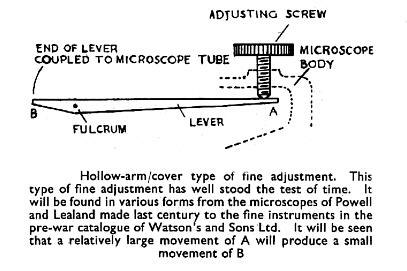 |
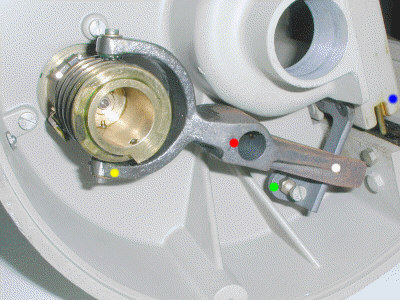 |
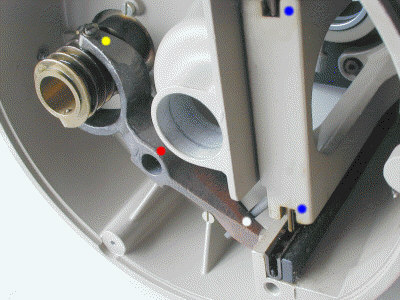 |
| Cam follower Pivot Stop Lever tip Ball race guide |
The movement is finally transmitted to the stage carrier unit via a 'leg' which supports an adjustable stop. The whole lever assembly is self tensioned through gravity, so there can never be any slackness , and thus will function perfectly and almost indefinitely so long as there is gravity!
Mechanical stage
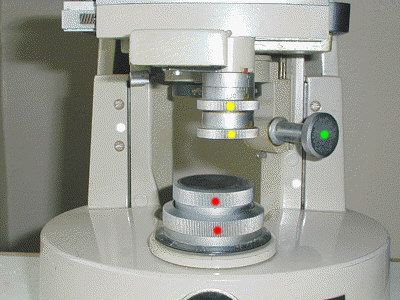 |
| Stage controls Focus
controls condenser focus
Stage roller guides |
Substage
This is a normal 39mm RMS supporting unit which has moderate focussing travel, and in the mount that I possess is an achromatic 1.25 NA condenser optic housed with iris control. There is provision for centralising this condenser using the two adjusting screws, and this works well, though the amount of movement is limited somewhat, but should be sufficient for most purposes. A darkground condenser was manufactured, but I have not seen this particular design.
Illumination
Standard illumination is electrically powered, but my particular Patholette came without the standard electric illumination lamphouse, so I improvised temporarily using an old mirror. A DIY lamp house and 90 degree prism assembly is a job for me to do this winter.
Optics
The objective changer can support 4 lenses, and this particular instrument came with some flatfield, and standard achromats, and a pair of x 7.5 B&L eyepieces.
The general standard of optical performance in the Patholette is good and certainly more than adequate for normal use. Vickers manufactured and supplied either standard achromat objectives, or achromat 'Micro plan', which have a flatter field; the latter are of good quality and compare quite favourably with European makers of that same period. They also supplied fluorite, and phase objectives.
The binocular head functions well, being easily adjusted for interocular distance. The left eyepiece holder can be focussed independently to provide for dioptric variations. At the base of the binocular, the makers have inserted a negative optical element to presumably alter the emerging rays of light to suit the 160mm tube length standard? I suspect this design is susceptible to knocks causing misalignment of internal prisms which are held by 'nipping' screws. A potential purchaser should be aware of this.
Summary
This microscope is a very interesting instrument with some novel features such as the lever focussing, with convenient placement of the co-axial controls for both the focussing and mechanical stage. It is portable, compact, and rigid as well as being stable, and the operation of the controls is quite intuitive .
There is however one particular feature which could lead to potential damage to the objectives or more likely the slide when the instrument is picked up. Since there is no obvious lifting point for the hand to grasp easily , it is entirely likely that the stage, which is free to move, can be drawn upwards against the slide or objective. Theoretically speaking this should not happen if the stage stop* has been properly set and tightened as it would have been done when leaving the maker. Those of you who might purchase this model should be aware of this, and always make sure no slide is in place if the instrument is handled bodily.
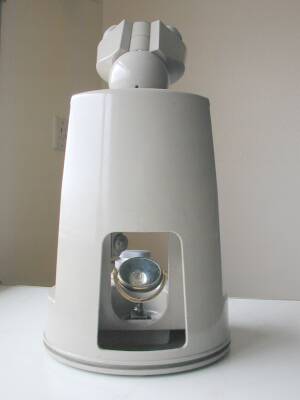 |
| Photo's taken with Nikon Coolpix 800 digicam |
| All comments to the author Paul James are welcomed. |
Please report any Web problems
or offer general comments to the
Micscape
Editor,
via the contact on current
Micscape Index.
Micscape is the on-line monthly
magazine of the Microscopy UK web
site at Microscopy-UK
WIDTH=1